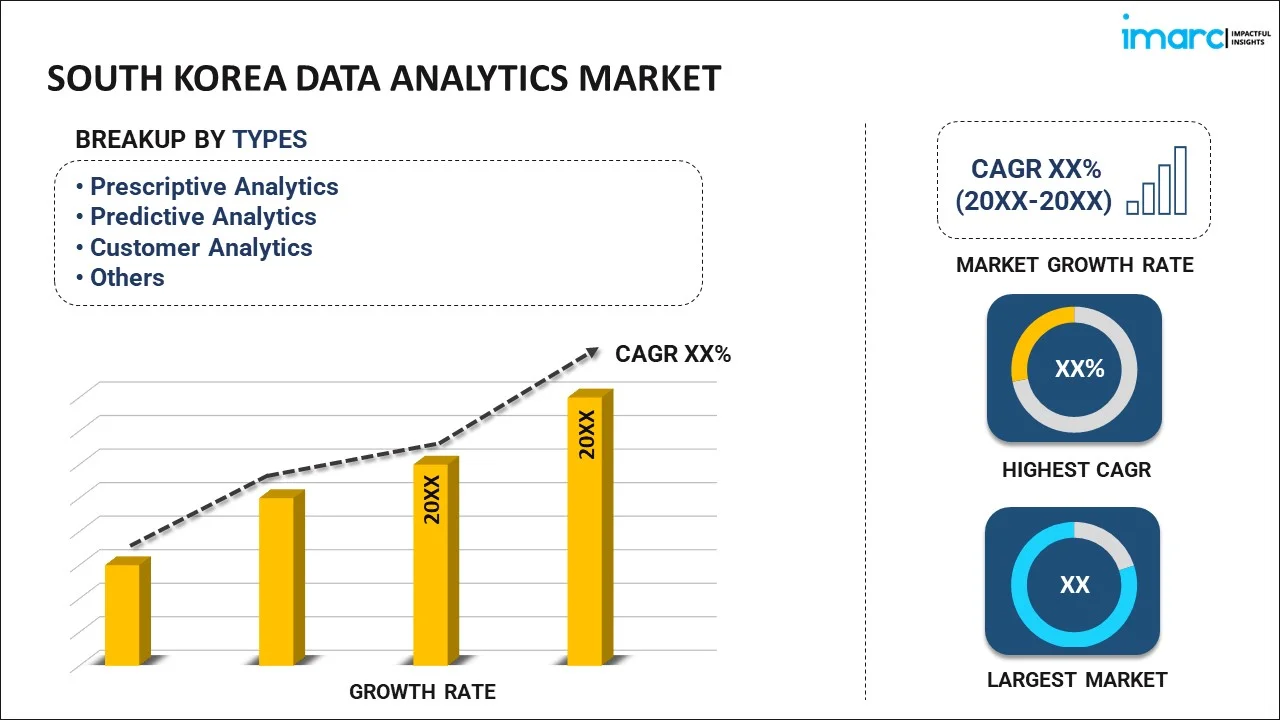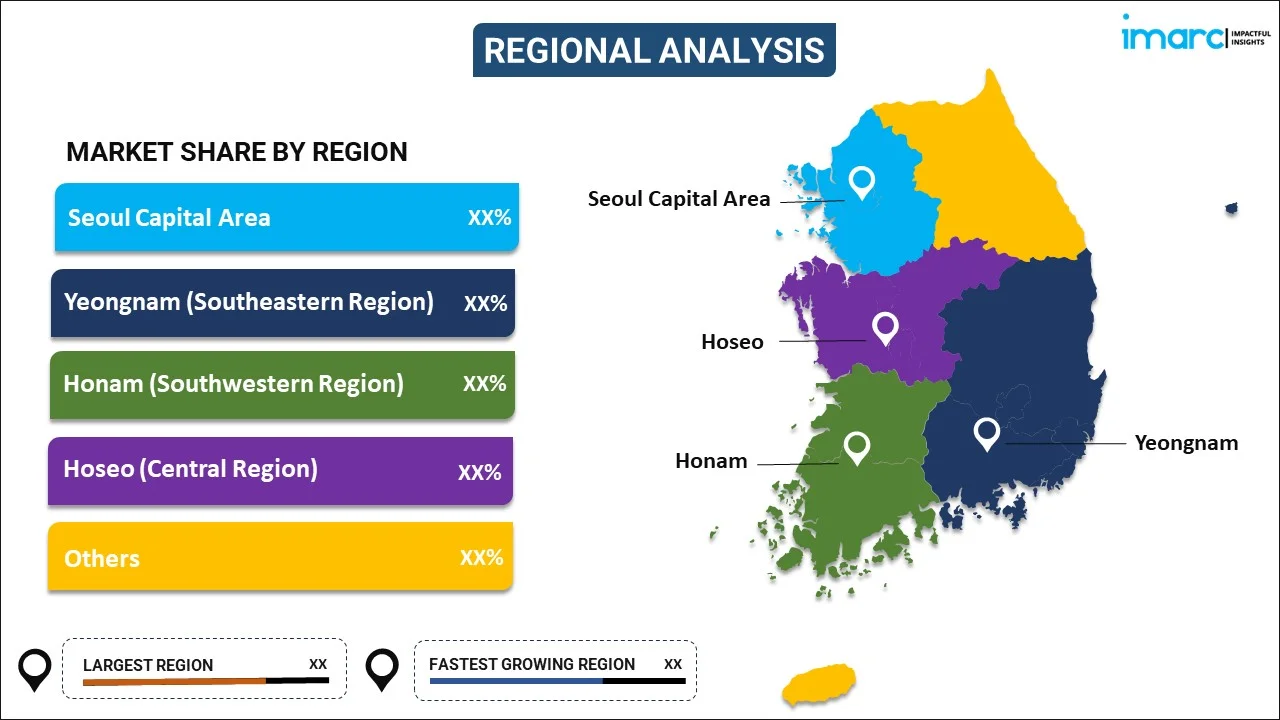
South Korea Data Analytics Market Report by Type (Prescriptive Analytics, Predictive Analytics, Customer Analytics, Descriptive Analytics, and Others), Solution (Security Intelligence, Data Management, Data Monitoring, Data Mining), Deployment (Cloud-based, On-premises), Application (Supply Chain Management, Enterprise Resource Planning, Database Management, Human Resource Management, and Others), and Region 2024-2032
Market Overview:
South Korea data analytics market size is projected to exhibit a growth rate (CAGR) of 31.30% during 2024-2032. The integration of machine learning and artificial intelligence technologies into data analytics tools, which enables more sophisticated analysis and prediction, is driving the market.
|
Report Attribute
|
Key Statistics
|
|---|---|
|
Base Year
|
2023 |
|
Forecast Years
|
2024-2032 |
|
Historical Years
|
2018-2023
|
| Market Growth Rate (2024-2032) | 31.30% |
Data analytics involves the examination, interpretation, and visualization of raw data to extract meaningful insights and facilitate informed decision-making. By employing various statistical, mathematical, and computational techniques, data analytics aims to uncover patterns, trends, and correlations within datasets. This process often includes cleaning and organizing data, applying statistical models, and utilizing advanced technologies like machine learning. Businesses and organizations leverage data analytics to enhance efficiency, identify opportunities, and mitigate risks. It plays a crucial role in transforming vast amounts of information into actionable intelligence, enabling stakeholders to make informed choices and optimize strategies. In essence, data analytics is a multifaceted discipline that empowers individuals and entities to harness the power of data for improved understanding, forecasting, and strategic planning.
South Korea Data Analytics Market Trends:
The data analytics market in South Korea is experiencing robust growth, propelled by several key drivers that collectively shape its trajectory. Firstly, the escalating volumes of data generated have become an impetus for organizations to harness the power of analytics to derive meaningful insights. With the proliferation of digital technologies, businesses are increasingly recognizing the need to capitalize on the vast reservoirs of data at their disposal. Furthermore, the advent of advanced technologies such as artificial intelligence and machine learning has revolutionized the data analytics landscape. These cutting-edge tools enable organizations to uncover intricate patterns and trends within data sets, fostering a more sophisticated and nuanced understanding of business dynamics. Additionally, the rising demand for real-time decision-making capabilities has spurred the adoption of analytics solutions that offer swift and accurate insights, enhancing operational efficiency. Moreover, the competitive landscape compels companies to leverage data analytics to gain a competitive edge. As organizations seek to stay ahead in their respective industries, the integration of analytics into decision-making processes becomes paramount. Additionally, the increasing awareness of the transformative potential of data analytics across diverse sectors further fuels the market growth in South Korea during the forecast period.
South Korea Data Analytics Market Segmentation:
IMARC Group provides an analysis of the key trends in each segment of the market, along with forecasts at the country level for 2024-2032. Our report has categorized the market based on type, solution, deployment, and application.
Type Insights:

- Prescriptive Analytics
- Predictive Analytics
- Customer Analytics
- Descriptive Analytics
- Others
The report has provided a detailed breakup and analysis of the market based on the type. This includes prescriptive analytics, predictive analytics, customer analytics, descriptive analytics, and others.
Solution Insights:
- Security Intelligence
- Data Management
- Data Monitoring
- Data Mining
A detailed breakup and analysis of the market based on the solution have also been provided in the report. This includes security intelligence, data management, data monitoring, and data mining.
Deployment Insights:
- Cloud-based
- On-premises
The report has provided a detailed breakup and analysis of the market based on the deployment. This includes cloud-based and on-premises.
Application Insights:
- Supply Chain Management
- Enterprise Resource Planning
- Database Management
- Human Resource Management
- Others
A detailed breakup and analysis of the market based on the application have also been provided in the report. This includes supply chain management, enterprise resource planning, database management, human resource management, and others.
Regional Insights:

- Seoul Capital Area
- Yeongnam (Southeastern Region)
- Honam (Southwestern Region)
- Hoseo (Central Region)
- Others
The report has also provided a comprehensive analysis of all the major regional markets, which include Seoul Capital Area, Yeongnam (Southeastern Region), Honam (Southwestern Region), Hoseo (Central Region), and Others.
Competitive Landscape:
The market research report has also provided a comprehensive analysis of the competitive landscape. Competitive analysis such as market structure, key player positioning, top winning strategies, competitive dashboard, and company evaluation quadrant has been covered in the report. Also, detailed profiles of all major companies have been provided.
South Korea Data Analytics Market Report Coverage:
| Report Features | Details |
|---|---|
| Base Year of the Analysis | 2023 |
| Historical Period | 2018-2023 |
| Forecast Period | 2024-2032 |
| Units | US$ Million |
| Scope of the Report | Exploration of Historical Trends and Market Outlook, Industry Catalysts and Challenges, Segment-Wise Historical and Future Market Assessment:
|
| Types Covered | Prescriptive Analytics, Predictive Analytics, Customer Analytics, Descriptive Analytics, Others |
| Solutions Covered | Security Intelligence, Data Management, Data Monitoring, Data Mining |
| Deployments Covered | Cloud-based, On-premises |
| Applications Covered | Supply Chain Management, Enterprise Resource Planning, Database Management, Human Resource Management, Others |
| Regions Covered | Seoul Capital Area, Yeongnam (Southeastern Region), Honam (Southwestern Region), Hoseo (Central Region), Others |
| Customization Scope | 10% Free Customization |
| Post-Sale Analyst Support | 10-12 Weeks |
| Delivery Format | PDF and Excel through Email (We can also provide the editable version of the report in PPT/Word format on special request) |
Key Questions Answered in This Report:
- How has the South Korea data analytics market performed so far and how will it perform in the coming years?
- What has been the impact of COVID-19 on the South Korea data analytics market?
- What is the breakup of the South Korea data analytics market on the basis of type?
- What is the breakup of the South Korea data analytics market on the basis of solution?
- What is the breakup of the South Korea data analytics market on the basis of deployment?
- What is the breakup of the South Korea data analytics market on the basis of application?
- What are the various stages in the value chain of the South Korea data analytics market?
- What are the key driving factors and challenges in the South Korea data analytics?
- What is the structure of the South Korea data analytics market and who are the key players?
- What is the degree of competition in the South Korea data analytics market?
Key Benefits for Stakeholders:
- IMARC’s industry report offers a comprehensive quantitative analysis of various market segments, historical and current market trends, market forecasts, and dynamics of the South Korea data analytics market from 2018-2032.
- The research report provides the latest information on the market drivers, challenges, and opportunities in the South Korea data analytics market.
- Porter's five forces analysis assist stakeholders in assessing the impact of new entrants, competitive rivalry, supplier power, buyer power, and the threat of substitution. It helps stakeholders to analyze the level of competition within the South Korea data analytics industry and its attractiveness.
- Competitive landscape allows stakeholders to understand their competitive environment and provides an insight into the current positions of key players in the market.
Need more help?
- Speak to our experienced analysts for insights on the current market scenarios.
- Include additional segments and countries to customize the report as per your requirement.
- Gain an unparalleled competitive advantage in your domain by understanding how to utilize the report and positively impacting your operations and revenue.
- For further assistance, please connect with our analysts.
 Inquire Before Buying
Inquire Before Buying
 Speak to an Analyst
Speak to an Analyst
 Request Brochure
Request Brochure
 Request Customization
Request Customization




.webp)




.webp)












